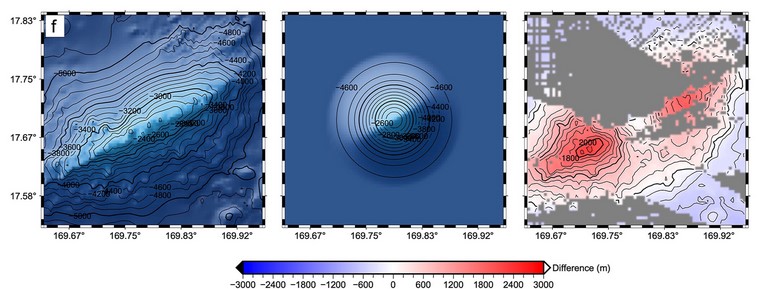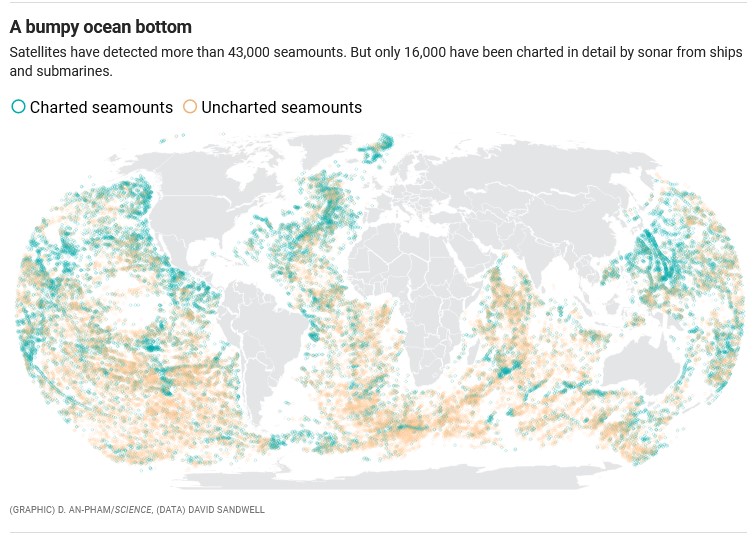https://joannenova.com.au/2023/04/the-science-is-settled-but-we-just-found-19000-new-volcanoes/
What would we know?
Underwater seamounts are one to four kilometer high mountains that mostly used to be a volcano. But under a kilometer of water they are hard to see, holy smoke, and we know more about the moon than the bottom of the Mariana, and it’s only 11km “away”.
Most of these undersea volcanoes remain uncharted by sonar, and with only one-quarter of the sea floor mapped, it is impossible to know how many exist. Sometimes we only find out when a nuclear submarine runs into one:
“It’s just mind boggling.” More than 19,000 undersea volcanoes discovered
New seamount maps could aid in studies of ecology, plate tectonics, and ocean mixing
Paul Voosen, Science
In 2005, the nuclear-powered USS San Francisco collided with an underwater volcano, or seamount, at top speed, killing a crew member and injuring most aboard. It happened again in 2021 when the USS Connecticut struck a seamount in the South China Sea, damaging its sonar array.
Despite discovering nearly half the known underwater volcanoes just this week, we already knew 30 years ago that they had no effect on the climate. The climate modelers said so. They explained that all the unexplained warming was due to CO2. Hence, ipso ergo absurdum, underwater volcanoes “equals zero”.
The Pacific Ocean cycles are the largest driver of climate on Earth, but we *know* as only high priests can, that volcanoes we’ve never studied definitely had no role in it.
Thanks to the laws of Government-funded Monopoly Science, the same researchers who would never point that out are now finding reasons that underwater volcanoes might help explain climate change. Now they tell us! Apparently “wake vortices make seamounts the leading contributor to upward ocean mixing, and a central player in climate.” Who knows, they might be right, but where were they twenty years ago when we needed more scientists to point out how inadequate climate models were?

For each seamount example, (left) SRTM15+V2.3 mapped bathymetry, (center) the average Gaussian Model where [omega/h] = 2.4, (right) difference between the average Gaussian model and real data. The gray areas have no soundings.
Seamounts may play another roll in upwelling of nutrients. These researchers point out that the eddys and currents flowing around seamounts may sweep up nutrients to the surface which feed vast pools of phytoplankton.
From Science:
The “upwelling” was once thought to happen evenly across the ocean, driven by turbulent waves at boundaries between deep ocean layers of different densities. Now, researchers believe it is concentrated at seamounts and ridges. “There’s a zoo of interesting things that happen when you have topography,” says Brian Arbic, a physical oceanographer at the University of Michigan, Ann Arbor.
When ocean currents curl around seamounts, they create turbulent “wake vortices” that can provide the energy to push cold water up, says Jonathan Gula, a physical oceanographer at the University of Western Brittany. In unpublished research, Gula and co-authors have found that these wake vortices make seamounts the leading contributor to upward ocean mixing, and a central player in climate. Since the team relied on the old Scripps catalog, not the new one, the effect of the seamounts is probably even larger, Gula adds.
Curiously, it was only two months ago we realized in another study that all the benzene and toluene pollution over the vast Southern Ocean was not caused by humans but by phytoplankton blooms. The aerosols produced by microbes can seed clouds, which in turn cool the planet.
There’s a 10,000 kilometer ball of magma under the sea floor. We don’t even know all the volcanoes on the crust, let alone the changes in temperature that might drive currents, or influence natural cycles.
Even as late as 2018 only 20% of the seafloor had been mapped by ships (Mayer et al., 2018). There’s a lot more to come.

Science: https://www.science.org/content/article/it-s-just-mind-boggling-more-19-000-undersea-volcanoes-discovered
People are constantly discovering new volcanoes, like a 3,000m one off Indonesia that no one realized was there til 2010. It turns out the second largest volcano in the solar system is apparently not on Io, but 1,000 miles east of Japan. It’s the size of the British Isles, but who knew? A few years ago a team found 91 new volcanoes under Antarctica. (This is getting serious, someone should talk to the Minister for Lava!)
For those who are curious, TechTimes has more details on how they found so many volcanoes. It involves radar satellite data and some Gaussian interpretation:
They measured sea surface altitude changes caused by gravitational pull using radar satellite data, a phenomenon known as sea mounding. This method resulted in the discovery of 19,000 previously undiscovered seamounts.
With their research, the team found that seamounts have a base-to-height ratio that is linearly related to their height, which means that their shapes are scale invariant. They used a mathematical model called a Gaussian function to calculate this characteristic shape and found that it can be used to accurately estimate the height of small seamounts.
h/t Eduard
REFERENCE
Hillier, J. K., and A. B. Watts (2007), Global distribution of seamounts from ship-track bathymetry data, Geophys. Res. Lett., 34, L13304, doi:10.1029/2007GL029874.
Julie Gevorgian et al, Global Distribution and Morphology of Small Seamounts, Earth and Space Science (2023). DOI: 10.1029/2022EA002331
Earth and Space Science, the new seamount catalog
https://www.science.org/doi/epdf/10.1126/science.adi3228


